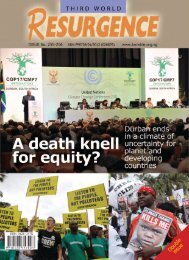Plantations, poverty and power - Critical Information Collective
Plantations, poverty and power - Critical Information Collective
Plantations, poverty and power - Critical Information Collective
You also want an ePaper? Increase the reach of your titles
YUMPU automatically turns print PDFs into web optimized ePapers that Google loves.
87<br />
Pöyry is working on second generation biofuels such as ligno-cellulosic ethanol <strong>and</strong> biomass-to-liquid<br />
fuel. Pöyry is looking at ways of integrating liquid biofuels production into existing pulp <strong>and</strong> paper mills.<br />
The company is involved in several bioenergy projects for pulp <strong>and</strong> paper companies. “With its combined<br />
know-how in the areas of forest industry, energy, environment <strong>and</strong> infrastructure, Pöyry is uniquely<br />
equipped to serve clients pursuing biomass-based projects,” writes Pöyry’s Peter Fabritius. 446 Pöyry’s<br />
North American offices are benefiting from the agrofuel bonanza in North America, winning several<br />
contracts for engineering services for agrofuel projects using corn, wheat <strong>and</strong> oilseed rape as the raw<br />
material. Pöyry is also sending trainees from other parts of the world to work in the company’s North<br />
American offices. “Trainees will return to their home office fully capable of taking on biofuel projects in<br />
their region of the world,” write Pöyry’s Zennie Lamarre <strong>and</strong> Otto von Ubisch. 447 Pöyry is also looking<br />
forward to getting winning contracts on wood-based second generation biofuel projects. “The potential<br />
for the North American forest industry to become a prime producer of biofuel is promising,” note<br />
Lamarre <strong>and</strong> Ubisch.<br />
One of Pöyry’s “solutions” to climate change is hydro<strong>power</strong>. Since taking over Electrowatt-Ekono in<br />
1999, Pöyry has become a major player in promoting <strong>and</strong> building dams worldwide. 448 Pöyry describes<br />
hydro<strong>power</strong> as “a renewable, emission-free, cost-efficient form of <strong>power</strong> generation,” 449 thus ignoring the<br />
impacts of dams on fisheries, local communities who must be evicted to make way for the reservoir,<br />
emissions from rotting biomass in the reservoir, siltation in reservoirs, cost overruns <strong>and</strong> massive<br />
subsidies. 450 In March 2004, Pöyry’s Canadian subsidiary, Jaakko Pöyry NLK Inc., organised an energy<br />
seminar for British Colombia’s pulp <strong>and</strong> paper industry. The seminar, which was jointly sponsored with<br />
BC Hydro, was held in BC Hydro’s Vancouver office. Pöyry presented Electrowatt-Ekono’s energy<br />
projects for the Nordic pulp <strong>and</strong> paper industry along with case studies <strong>and</strong> comparisons with the<br />
Canadian <strong>and</strong> US pulp <strong>and</strong> paper sectors. 451<br />
Inevitably, Pöyry’s “solutions” to climate change also include large-scale industrial tree plantations.<br />
According to Pöyry, plantations “represent significant potential to . . . [a]bsorb carbon emissions <strong>and</strong> act<br />
as carbon sinks”. 452 Writing about the development of plantations in Australia, Pöyry’s Rob de Fégeley<br />
noted that although most plantations established in Australia are “primarily commercial”, there “is now<br />
increasing interest in dual commercial/environmental plantations which can assist Australia address some<br />
of its environmental concerns.” Australia’s “environmental concerns”, according to de Fégeley, include<br />
“salinity control, sequestering carbon <strong>and</strong> improving the biodiversity in rural regions where it has been<br />
446 Peter Fabritius (2007) “Increased energy production based on biomass in the pulp <strong>and</strong> paper industry”, Know-How<br />
Wire, Pöyry Client Magazine, 2/2007.<br />
447 Zennie Lamarre <strong>and</strong> Otto von Ubisch (2007) “Oil-dependence sparks bio-energy boom in North America”, Know-<br />
How Wire, Pöyry Client Magazine, 2/2007.<br />
448 For more information on Electrowatt-Ekono’s record, see Chris Lang <strong>and</strong> Nick Hildyard (2003) “Dams Inc 2:<br />
Electrowatt-Ekono”, 21 January 2003.<br />
449 Patrick von Essen (2007) “Services <strong>and</strong> solutions for the fight against climate change”, Know-How Wire, Pöyry<br />
Client Magazine, 2/2007.<br />
450 See for example, Patrick McCully (1996) “Silenced Rivers: The Ecology <strong>and</strong> Politics of Large Dams”, Zed Books.<br />
For a critique of Electrowatt-Ekono’s involvement in the hydro<strong>power</strong> sector see: Chris Lang <strong>and</strong> Nick Hildyard (2003)<br />
“Dams Inc. 2: Electrowatt-Ekono”, available here: http://www.box.net/shared/lfgnckdi5q<br />
451 Gordon Floe (2004) “Joint energy seminar by Jaakko Pöyry NLK <strong>and</strong> BC Hydro ”, Know-How Wire, Jaakko Pöyry<br />
Client Magazine, June 2004.<br />
452 Hannu Hynnönen (2008) “Planting the future”, Know-How Wire, Pöyry Client Magazine, 1/2008.<br />
http://www.poyry.com/linked/en/press/KnowhowWire_1_2008.pdf















